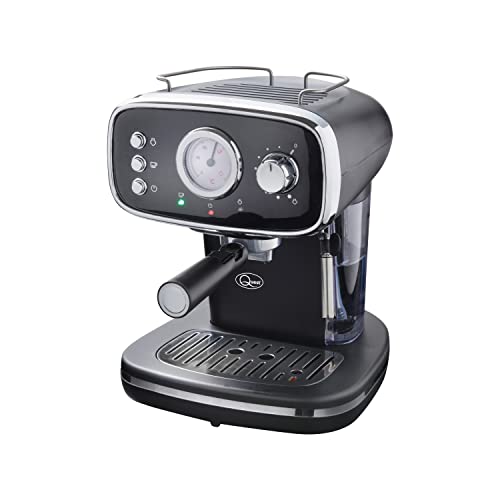How Does Machine Espresso Work?
The machine espresso is made using precision pressure, and a filtering system that is awe-inspiring to make the coffee you love. What exactly is it that makes it work?
To make an espresso hot water is pushed under pressure through finely ground coffee. The process is similar to making drip coffee. However the pressure is the primary difference.
The Head of the Group
The group head is the portafilter you insert when brewing espresso. It is responsible for dispersing water into the portafilter and then controlling the pressure of the resulting extraction. There are many different types of group heads each with their own advantages and disadvantages. Some are focused on temperature stability, others on pre-infusion features, and others are designed to control the lever. There are also some that contain a variety of features, like the E61, which is considered the classic choice among many baristas due to its capacity to provide multiple benefits in a single package.
As you can see from the above photo, the group head is fitted with a variety of notches. The portafilter is placed into these notches and twist the head to lock it. There is also a gasket made from rubber which is located inside the notches and helps to create an airtight seal when you insert your portafilter into the machine. The notches allow for precise placement of your portafilter. This is essential for a consistent extraction.
The group head not only allows you to put in your portafilter easily however, it also keeps the temperature at a constant level. This is achieved by cycling hot water around the portafilter, and through the brew-basket, ensuring the temperature is always right for extraction. This is important, as even a few degrees can make the difference between excellent and great espresso.
The Pump
Contrary to manual piston machines that use a lever to pressurize water, the rotary espresso machines use motorized pumps to deliver the nine atmospheric bars of pressure needed for espresso extraction. The pressure builds by drawing tap water from a reservoir, and pumping it through a heat exchanger before being pushed through the ground coffee in the group head.
Pumps are generally less expensive than piston-driven machines, and they tend to last longer. However, both types of machine can become damaged due to excessive use and poor cleaning. They also increase the complexity of mechanical systems and can lead to the cost of even the most basic models.
Certain espresso machines remove the pump entirely and utilize steam pressure to make espresso. This can cause over-extraction because the boiler that makes steam also warms the water to boil. The machines must also constantly rebuild their pressure in between cups. This takes energy and time.
A large majority of espresso machines employ a rotary or vibration pump. A vibration model utilizes an oscillating disk to create pressure, while the rotary model pushes hot water through the ground at a high speed. Both machines can make great espresso but rotary machines are more stable, quieter and less likely to break.
The Boiler
The boiler is the one that is used to heat the water to the perfect temperature for extraction. The steam that is produced will eventually reach the portafilter, which holds the espresso grounds. It is then poured into the cup. The steam creates pressure and pushes through the grounds of the coffee. This creates a layer crema on top. This is the hallmark of a good espresso.
There are three kinds of espresso machines, each with different types of pumps and the temperature of the brew. There are many ways to control the brew as well as the size of the cup that can be made by the machine.

The first espresso machines were steam-types. The first espresso machines were steam-type machines. This led to the coffee tasting burnt and bitter. websites was developed by the Milanese producers Luigi Bezzerra & Desiderio Pavoni.
The most well-known espresso machine is a semiautomatic with an electric pump. When people think of espresso machines, they envision these machines. Semi-automatic machines require you to grind and tamp the beans yourself however the pump controls the water flow and pressure. This is an excellent compromise between human touch and the mechanized consistency.
The Filter
Espresso machines usually use filters that separate the grounds of the coffee from hot water. The filter is also an essential part of the machine's temperature control, as it helps prevent overheating.
Filters also aid in flavor as it allows for a longer flowering phase. This allows the beans to release their flavor and improves extraction.
However, it is important to keep in mind that even a high-quality filter can make a terrible cup of coffee as the quality of the beans and extraction is still crucial.
It's here that the magic takes place. This is the reason why espresso tastes so good. The grouphead (also called the brewhead) is where you put the portafilter, the thingy that you use to put the grounds of your coffee into when making espresso.
In a steam-driven espresso machine, hot water is heated in an airtight container to create steam. Steam is then pushed through the grounds at a high pressure. They are less expensive and are easier for the user to maintain than pumps-driven models. However, they are limited in their ability to create the ideal brewing conditions, as they only operate at 1-1.5 bars of pressure. However, the perfect shot requires 9-10 bar.
In recent times, espresso machines powered by compressed air-pump are becoming increasingly popular. They utilize an air compressor to push hot water into the grounds and are more portable than steam-driven electric machines.
